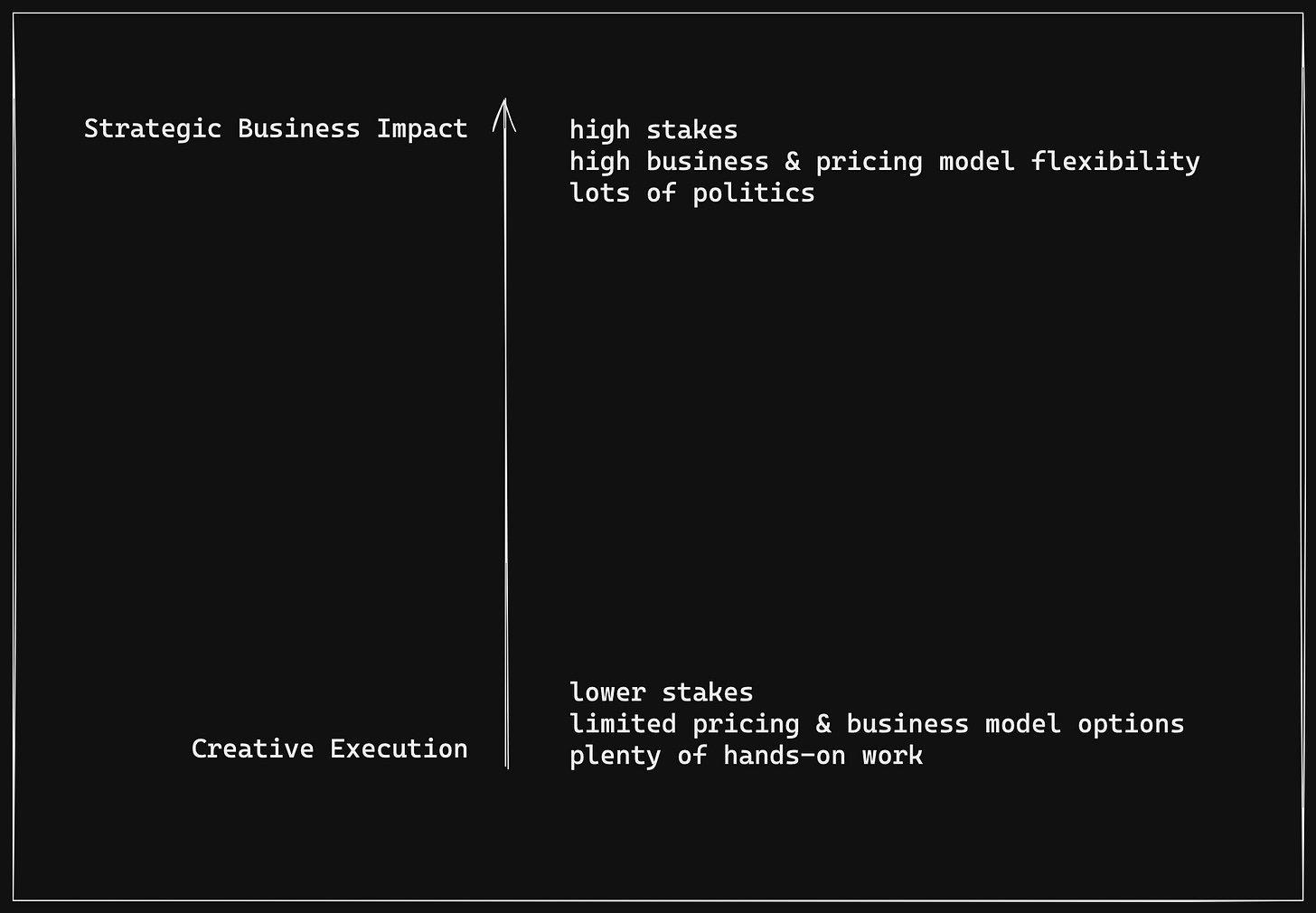Hi there.
Let's get into a rabbit hole. It's a rabbit penthouse, actually. On the door, the label reads: value pricing. Behind the door, there's a maze of connections, and numerous intersections of two concepts: Value Chain and Value Creation.
Why am I even touching this?
I'm seeing creative studios struggling with two critical concepts: positioning of their offering and value-based pricing. Both these subjects got a fair bit of exposure from experts, educators and thought leaders, yet when you look at how it translates into business practice… Oh boy!
The problem boils down to the fact, that ability to practically apply value-based pricing and to position your firm successfully requires a crucial ingredient.
And I haven't seen this being talked about enough.
And this is understanding the value chain, and your placement in that value chain.
What is value chain?
In a nutshell - that's an entire ecosystem of connected companies working together to achieve client's goal. It could be thought of command chain too.
Think of a client. A big corporation. Most likely, they would have their agency of record — being a true success partner for their brand and marketing.
In parallel, especially recently, there's going to be some additional smaller, independent firms doing this or that.
Let's say they launch a new product. There's a launch strategy, events, a campaign to be produced and a TV commercial to be made.
Following strategic development, budget allocation and strategizing execution, the agency would hire a production house to shoot a launch film. What's a production house? Another agency — a group of people in charge of making things happen.
They would hire a director, and/or creative director, bring together a team to shoot, service the production, bring a post house, and often a specialized CG, VFX or animation partner.
Quite a lot of entities, and despite a "collaborative" vibe, it's a hierarchical structure, much resembling a chain of command in military.
We know the drill.
Value chain graph
Where it's getting interesting is plotting these firms on a graph.
What graph you may think? Let's call it a value chain graph.
Imagine strategic impact on top, creative execution on the bottom.
We'll plot the companies there, and then we'll start switching labels.
Quite obvious, isn't it?
Now let's switch labels.
It's a system, designed to produce outputs efficiently.
Now imagine you're playing with the system, trying to swap roles on various levels.
What is the impact of each change on the whole undertaking? And on specific aspects of the. undertaking?
If you look at the top, replacing an agency in charge of this big launch will yield entirely different approaches to what to do and how to launch it.
Swapping a production house will still impact the outcomes big time, but the impact will be more local and less global.
Then, swapping a company responsible for delivering these creative transitions between the shots, as envisioned by the director and sitting in a wider context defined by the agency. This is perhaps going to impact a bit of the creative outcome, but what's more important than how amazing these transitions are, would be how fast, reliable or easy to work with they are.
Don't rush through this.
It's really worth it to explore the role play on each of the nodes. The goal is understanding a big picture of what decisions and responsibilities are taking place on each of these levels, and what defines a good choice when playing with options to fill in each of the nodes.
"When you know where you stand in the value chain, you can start climbing to the top."
Why is it important?
Now why am I bringing it?
Because so often I see 3D animation companies trying to position themselves as the ones solving agency's problems. That's poised for failure in most cases, because it establishes your positioning choices on faulty placement in the value chain.
If you're a 3D animation studio, you don't compete against agencies. Nor should you pretend to deliver results that are typically guaranteed by the agency.
Yet, so often this happens.
Firms start crafting their positioning without understanding where they sit in the chain!
It's like entering a boxing ring without choosing a weight category first.
It's like entering a boxing ring without choosing a weight category first.
Then on each of layers, you'll have specific amount of freedom to shape your positioning, and the boundaries are to some extent bendable.
Imagine your firm caters equally towards brands, agencies and production houses.
How can this work? If you want to work with brands, you're an agency competitor. If so, good luck working with that agency. If you work for production houses and act like a production house at times, it's clearly a risk when they think about hiring you.
Of course, there are situations where this is more nuanced, and you can imagine a successful business model where you work with both, but with a range of limitations and caveats.
The value chain we plotted here is just an example, there's so many different options, depending on where you are and who you care about.
Once you have a good understanding of where you want to sit in the value chain, you can start thinking about how to create value and differentiation.
If you're working as a CG studio in the ecosystem that we plotted, it makes zero sense to advertise your strategic prowess. That's simply not your job. You don't need it nor do your clients. And if you have it and try to geek out, you'll get yourself into troubles.
Same goes if you try to position yourself as a partner to another more established CG studio. You can build a thriving business working for the bigger guns like you, but the game you play is a vendor game — with its own challenges and possible wins.
Stepping up in the value chain
But, if you are CG studio and think about serving smaller firms directly, it's virtually impossible to get signed for a good deal if you don't mix in some creative strategy, and business mindset. Unless, you work as an execution arm to their internal marketing team.
Stop selling CG. Instead, think about how your CG can fuel business goals of the client.
Stop selling art; start selling impact.
"The leap from vendor to strategic partner is paved with shared goals and shared successes."
Value based Pricing
Now that you have a bit of feeling about how this works, let's think about the idea of value pricing. So many people get that wrong.
"Value pricing isn’t just about charging more—it's about charging right."
Back to our TVC example, as a CG firm supporting a post house working for a production house, hired by an agency, you have very little chance to apply value-based pricing in practice. Why is it so? Simply, because you're operating within a narrow field of expertise and your positive impact on the business result is rather low.
"What barriers exist in our current business model that prevent us from adopting a value-based pricing strategy?"
The producers will ask you for a sort of budget that looks either as a T&M sheet or at best, will be a list of deliverables with price. That makes sense. That's how the system works. You can't have a true value conversation with a prod house producer.
"What specific outcomes do we influence for our clients, and how can we measure and communicate this impact?"
Side note - while your positive business impact is limited, your negative impact is potentially high, because if you underdeliver, the whole thing collapses. That's why if you want these kind of jobs, you play on security of hiring you.
So when would it make any sense to even think about value pricing?
The rule of thumb should be the closer to the client you are, and the more business impact is at stake, the more sense it makes to talk value.
In what ways can we move from being seen as a cost to an investment?
How can we reframe our client conversations to focus on business outcomes rather than just creative output?
Does it mean being on the bottom, on the execution side, is a bad business positioning? By no means. You can build an empire there, and have a fairly profitable business. Provided you understand clearly the game you play and the dynamics. The game to master is operations and efficiency.
How can firms at the execution level differentiate their services to create more value?
Differentiating your firm
So how to differentiate?
Let's talk about differentiation quickly. Once you positioned yourself on the value chain map, it's time to look around.
How does our current position in the value chain limit or enhance our pricing power?
Who are you competing against? What are the people hiring you and your competitors selecting for? What are their personal and professional motivations? What's the leeway they have in the system with respect to types of firms they can work with?
To position yourself well, you need sleep with your clients — that is understand exactly the environment they operate in, the values they seek, and understand what choices they have.
You don't do that by hiring (or playing) a copywriter, opening a thesaurus, and coming up with some fancy words for the same thing.
As I often say: positioning is not a copywriting problem. It's a business strategy problem.
Only from that deep and intimate understanding of the environment you can craft a compelling value proposition.
"Your creativity has a direct line to their bottom line. Map it, show it, price it."
Further exploration
This insight is not about the definitive answers.
It's about setting a good perspective to approach the subjects of positioning, value creation and value pricing.
Let's think about further explorations, and questions you'd like to ask yourself:
Strategic Position vs. Operational Execution: Where does your firm fall on this spectrum? How does this influence your client engagements and pricing models?
Direct Impact on Client Success: How directly does your work impact your client's bottom line or strategic goals?
Value Chain Integration: How integrated are your services with the core operations or success of your clients?
Business Model Innovation: What innovative pricing or service models can better align your firm’s capabilities with market opportunities?
Partnership and Collaboration: How can shifting from a vendor to a partnership model transform client relationships and business outcomes?
Hey, give me a shout if this subjects resonate with you and where you are on your value creation and positioning path.
Need individual help? Shall we dive deeper into theory? Maybe you'd like to take part in a mastermind around these subjects?
Stay prolific,
Till the next one
















